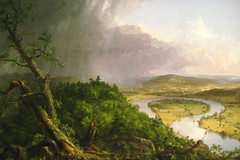AMSCO United States History 2015 Edition, Chapter 11 Society, Culture, and Reform, 1820-1860
| 5675213850 | utopian communities | Over one hundred of these experimental communities were started in the 1820s to 1860s period. (p. 210) |  | 0 |
| 5675213851 | Shakers | This early religious communal movement held property in common and separated men and women. Forbade marriage and sexual relations (p. 210) |  | 1 |
| 5675213853 | Robert Owen | A Welsh industrialist and reformer who founded the New Harmony community and leader in utopian community ieals(p. 210) |  | 2 |
| 5675213854 | New Harmony | Nonreligious experimental socialist community founded to solve problems of inequity and alienation caused by the Industrial Revolution. (p. 210) |  | 3 |
| 5675213856 | Oneida community | This community, started in 1848, was dedicated to social and economic equality. They shared property and spouses, and prospered by manufacturing silverware.. (p. 210) |  | 4 |
| 5675213858 | Horace Mann | He was the leading advocate of the public school movement. (p. 213) |  | 5 |
| 5675213859 | temperance | Reformers targeted alcohol as the cause of social ills. The movement started by using moral exhortation, then shifted to political action. Business leaders and politicians supported it because it improved productivity of industrial workers. (p. 212) |  | 6 |
| 5675213860 | American Temperance Society | Founded in 1826, by Protestant ministers and others, they encouraged total alcohol abstinence. (p. 212) |  | 7 |
| 5675213862 | Women's Christian Temperance Union | In the late 1870s, this women's organization was part of the temperance movement. (p. 212) |  | 8 |
| 5675213863 | asylum movement | In the 1820s and 1830s, this movement sought to improve the conditions for criminals, emotionally disturbed people, and paupers. They proposed setting up state-supported prisons, mental hospitals, and poorhouses. (p. 212) |  | 9 |
| 5675213864 | Dorothea Dix | A reformer who was responsible for improving conditions in jails, poorhouses and insane asylums throughout the U.S. and Canada. She succeeded in persuading many states to assume responsibility for the care of the mentally ill. (p. 212) |  | 10 |
| 5675213867 | penitentiaries/prisons | These institutions took the place of crude jails. They believed that structure and discipline would bring about moral reform. (p. 213) |  | 11 |
| 5675213869 | public school movement | In the 1840s, this movement to provide free education for all children (through public funding) spread rapidly throughout the nation. Other reforms included longer terms and segregation by age (p. 213) |  | 12 |
| 5675213872 | American Colonization Society | Founded in 1817, this organization transported free black people to an African colony. This appealed to moderates, racists, and politicians. However, only 12,000 people were actually settled in Africa. (p. 215) |  | 13 |
| 5675213873 | American Antislavery Society | The organization was founded in 1833 by William Lloyd Garrison and others. They advocated the immediate abolition of all slavery in every state. (p. 215) |  | 14 |
| 5675213874 | abolitionism William Lloyd Garrison; The Liberator | In 1831, he started the radical abolitionist movement with the "The Liberator" newspaper. He advocated the immediate abolition of all slavery in every state. (p. 215) |  | 15 |
| 5675213876 | Frederick Douglass; The North Star | In 1847, this former slave started the antislavery journal, "The North Star". (p. 215) |  | 16 |
| 5675213877 | Harriet Tubman | Famous abolitionist, born a slave, she assisted fugitive slaves to escape to free territory. (p. 215) |  | 17 |
| 5675213879 | Sojourner Truth | A United States abolitionist and feminist who was freed from slavery and became a leading advocate for the abolition of slavery and the rights of women. (p. 215) |  | 18 |
| 5675213883 | Nat Turner | In 1831, he led the largest slave rebellion in which 55 whites were killed. (p. 215) |  | 19 |
| 5675213884 | antebellum period | The period before the Civil War started in 1861. (p. 207) |  | 20 |
| 5675213885 | romantic movement | In early 19th century Europe, art and literature emphasized intuition and feelings, individual acts of heroism, and the study of nature. In America, similar themes were expressed by the transcendentalists. (p. 209) |  | 21 |
| 5675213886 | transcendentalists | They questioned the doctrines of established churches and business practices of the merchant class. They encouraged a mystical and intuitive way of thinking to discover the inner self and look for essence of God in nature. Artistic expression was more important than pursuit of wealth. They valued individualism and supported the antislavery movement. (p. 209) |  | 22 |
| 5675213887 | Ralph Waldo Emerson, "The American Scholar" | The best known transcendentalist, his essays and lectures expressed the individualistic and nationalistic spirit of Americans. He urged self-reliance, and independent thinking, primacy of spiritual matters over material ones. critic of salvery(p. 209) |  | 23 |
| 5675213888 | Henry David Thoreau, "Walden", "On Civil Disobedience" | A pioneer ecologist and conservationist. He was an advocate of nonviolent protest against unjust laws. transcendentalist, observed nature to discover truths about life and the universe. (p. 209) |  | 24 |
| 5675213891 | feminists | The term for advocates of women's rights. (p. 214) |  | 25 |
| 5675213892 | Margaret Fuller | A feminist, writer, and editor in the women's movement. (p. 210) |  | 26 |
| 5675213898 | Hudson River school | In the 1830s, this genre of painting founded in the Hudson River area, portrayed everyday life of ordinary people in the natural world. (p. 211) |  | 27 |
| 5675213899 | Washington Irving | This author wrote fiction using American settings. (p. 211) |  | 28 |
| 5675213901 | Nathaniel Hawthorne | Author of "The Scarlet Letter", which questioned the intolerance and conformity in American life. (p. 211) |  | 29 |
| 5675213902 | Sylvester Graham | An American dietary reformer who advocated whole wheat bread and graham crackers to promote good digestion. (p. 216) |  | 30 |
| 5675213904 | Second Great Awakening | A religious movement that occurred during the antebellum period. It was a reaction against rationalism (belief in human reason). It offered the opportunity of salvation to all. Rejected Calvinism; paralleled democratization of American society (p. 207) |  | 31 |
| 5675213906 | revivalism; revival camp meetings | In the early 1800s, this movement was a reaction against the rationalism of the Enlightenment. Successful preachers were audience-centered and easily understood by the uneducated. (p. 207) |  | 32 |
| 5675213908 | Church of Jesus Christ of Latter-Day Saints; Mormons | Founded by Joseph Smith in 1830. It was based on the Book of Mormon which traced a connection between the American Indians and the lost tribes of Israel. After Joseph Smith was murdered, Brigham Young led the religious group to establish the New Zion on the Great Salt Lake in Utah. (p. 208) |  | 33 |
| 5675213909 | Joseph Smith | Founded the Church of Jesus Christ of the Latter-Day Saints in New York in 1830. The church moved to Ohio, Missouri, Illinois, then finally to Utah. (p. 208) |  | 34 |
| 5675213910 | Brigham Young | After Joseph Smith was killed, he led the Mormon followers to Utah. (p. 208) |  | 35 |
| 5675213912 | women's rights movement | Women started this movement because they resented the way men relegated them to secondary roles in the reform movements. (p. 214) |  | 36 |
| 5675213913 | cult of domesticity | After industrialization occurred women became the moral leaders in the home and educators of children. Men were responsible for economic and political affairs. (p. 214) |  | 37 |
| 5675213916 | Lucretia Mott | A women's rights reformer who was not allowed to speak at an antislavery convention. (p. 214) |  | 38 |
| 5675213917 | Elizabeth Cady Stanton | A women's rights reformer who was not allowed to speak at an antislavery convention. (p. 214) |  | 39 |
| 5675213918 | Seneca Falls Convention | In 1848, this was the first women's rights convention in U.S. history. They wrote a "Declaration of Sentiments", modeled after the Declaration of Independence, which declared all men and women equal and listed grievances. (p. 214) |  | 40 |
| 5675213919 | Susan B. Anthony | Social reformer who campaigned for womens rights, the temperance, and was an abolitionist. She helped form the National Woman Suffrage Association. (p. 214) |  | 41 |
| 5675407244 | Baptists and Methodists | In south and advancing western frontier, circuit preachers, by 1850, largest Protestant denominations in the country | 42 | |
| 5675505493 | higher education | religious enthusiasm of Great Awakening helped fuel growth of private colleges. | 43 |

